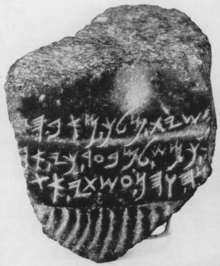El-Kerak Inscription
The El-Kerak Inscription was discovered in 1958 in Jordan, near the El-Kerak wadi. It is a basalt inscription fragment measuring 12.5 centimeters (4.9 in) high by 14 centimeters (5.5 in) wide. The inscription has been dated to the late ninth century BC. The inscription is known as KAI 306.
| El-Kerak Inscription | |
|---|---|
 The inscription | |
| Material | Basalt |
| Writing | Moabite language |
| Created | c.840 BC |
| Discovered | 1958 |
| Present location | Jordan Archaeological Museum |
| Identification | 6807 |
Discovery
The stone was acquired by the Jordan Archaeological Museum in 1958. It was reportedly found by Falah Qaddur (or Fallah el-Baddour), a bedouin from the Tafilah Governorate. According to Reed and Winnett, Qaddur stated that he had found the stone "in a foundation trench that had been cut for the construction of a new building in Al Karak." A letter from Awni Dajani, then the head of antiquities at the Jordan Archaeological Museum, stated that the stone was found by Odeh Subh el-Khwalideh (a relative of Qaddur) in the house of Suleiman el-Mubayyedin, near the Roman Pool east of Kerak.
Inscription
The inscription contains 3 incomplete lines, comprising 8 complete words and fragments of 5 more, all written in the "Moabite language" known from only one other artifact - the Mesha Stele. The text of the inscription looks like that of the Mesha Stele, but there is one special feature: the letter He has four horizontal strokes going to the left from the vertical stroke, while a typical He in tenth to fifth century BC northwest Semitic inscriptions contains only three strokes to the left. This letter is present in the inscription at least 3 times, and each time it appears with 4 horizontal strokes. Another difference between the Mesha Stele and the Moabite inscription, is the separation between the words. In the Mesha Stele there are dots, and in the Moabite inscription there are small lines.
Transliteration and translation
Provided below is transliteration and transcription of the inscription in Hebrew letters as well as its English translation.[1][2] Words in brackets are not preserved in the inscription, but reconstructed, partly by comparison with the Mesha Stele.
| Line | Transcription | Transliteration | English translation |
|---|---|---|---|
| 1 | [אנכי כמשגד בן כ]משית מלך מאב הד[יבני] | [’anākū kamāšgād bēn ka]māšūyat malēk mā’āb hadū[bānū] | [I am Chemosh-gad, son of Ch]emosh-yat, king of Moab the Dib[onite]... |
| 2 | [בבת]י כמש למבער כי אה[בתי] | [babēt]ū kamāš lamaba‘ēr kū ’āha[batū] | [... in the te]mple of Chemosh as a sacrifice, because I lo[ve...] |
| 3 | [...]נה והן עשתי את[...] | [...]nh wahēn ‘āšūtū ’t[...] | ... and behold, I have made ... |
Further reading
- A Fragment of an Early Moabite Inscription from Kerak, William L. Reed and Fred V. Winnett, Bulletin of the American Schools of Oriental Research, No. 172 (Dec., 1963), pp. 1–9
References
- El Kerak Inscription page
- "Drawing by Christopher A. Rollston and transcription". Archived from the original on 2012-04-26. Retrieved 2011-12-20.